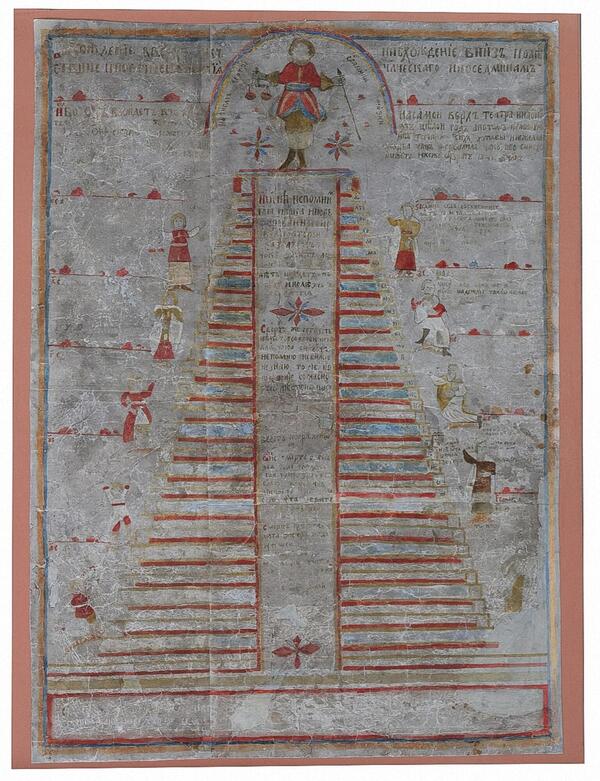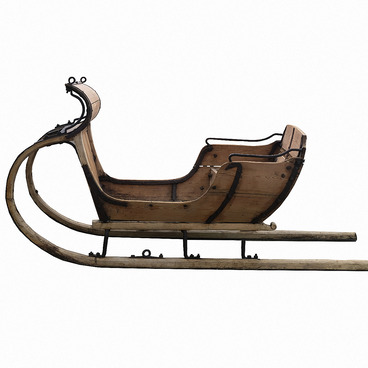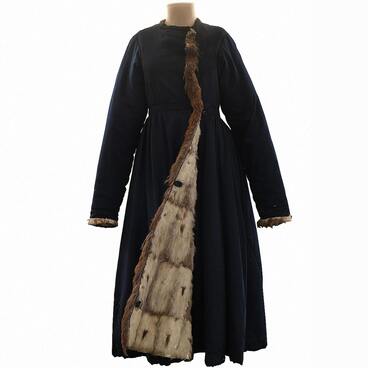Wall-drawn luboks (a specific type of graphic art that was popular in Russia in the mid-17th –late 19th centuries) are small pictures made by hand, with simple images and a clear plot. This type of lubok appeared in the mid-18th century. This art was initiated by the Old Believers: to substantiate the truth of their faith, they used visual ways to convey information.
Masters made wall pictures without using printing techniques like engraving: the drawing itself, its coloring, titles and explanatory texts — everything was created exclusively by hand. Therefore, each piece was unique.
The plot “The Ages of Human Life” is devoted to reflections on its different periods. A staircase in the form of a triangle is visible in the center, steps are drawn on its sides. There is a young man standing at the top.
It was believed that a person can live 70 years, and life is like a ladder, where 35 steps lead up, and 35 steps lead down. The sides of the stairs depict different pastimes that correspond to every seven years of life — a sennight.
It was believed that people begin their ascent from birth. In the first week, a person is still a baby and does not understand anything. The second week corresponds to the age from 7 to 14 years. At this time, the main thing in life is games, playfulness, idleness and unbridled pride. The third week is under the age of 21. During this period, young men already appreciate the beauty of clothes and accessories, they begin to take an interest in the opposite sex.
The fourth week is considered to be up to 28 years old: at this time, a man tries to arrange a marriage and enrich himself, but at the same time he also feels some sadness, worldly vanity. By the age of 35, in the fifth week, all thoughts revolve around home improvement. At this time, a person reaches his peak: he becomes perfect in strength and intelligence, in reasoning. At the very top of the ladder, he reaches balance for a whole year.
But then inevitably there is a descent down: the next three weeks show a life full of diseases and suffering. A similar lubok was published in Dmitry Rovinsky’s book “Russian Folk Pictures”. It was said in his text that by age 70 a person
Masters made wall pictures without using printing techniques like engraving: the drawing itself, its coloring, titles and explanatory texts — everything was created exclusively by hand. Therefore, each piece was unique.
The plot “The Ages of Human Life” is devoted to reflections on its different periods. A staircase in the form of a triangle is visible in the center, steps are drawn on its sides. There is a young man standing at the top.
It was believed that a person can live 70 years, and life is like a ladder, where 35 steps lead up, and 35 steps lead down. The sides of the stairs depict different pastimes that correspond to every seven years of life — a sennight.
It was believed that people begin their ascent from birth. In the first week, a person is still a baby and does not understand anything. The second week corresponds to the age from 7 to 14 years. At this time, the main thing in life is games, playfulness, idleness and unbridled pride. The third week is under the age of 21. During this period, young men already appreciate the beauty of clothes and accessories, they begin to take an interest in the opposite sex.
The fourth week is considered to be up to 28 years old: at this time, a man tries to arrange a marriage and enrich himself, but at the same time he also feels some sadness, worldly vanity. By the age of 35, in the fifth week, all thoughts revolve around home improvement. At this time, a person reaches his peak: he becomes perfect in strength and intelligence, in reasoning. At the very top of the ladder, he reaches balance for a whole year.
But then inevitably there is a descent down: the next three weeks show a life full of diseases and suffering. A similar lubok was published in Dmitry Rovinsky’s book “Russian Folk Pictures”. It was said in his text that by age 70 a person



